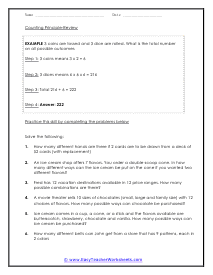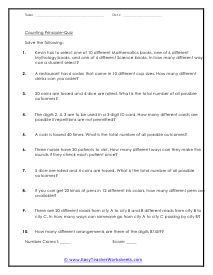The counting principle is the method by which you determine the number of outcomes in a probability problem. To obtain the number of outcomes, you multiply the events together to get the total number of outcomes. You unitedly multiply the cases for total vale of results. Formula: Event a & b then, Total no of results=(a x b) Example#1: Special deal of a fast-food Center: Drink, sandwich, side item, dessert = $5. Options: Sandwich: Chicken/ Beef Patty Side: Regular fries/Cheese Fries Dessert: Chocolate/Apple Pie. Drink: Fanta/Coke/Diet Coke Find possible no of deals? Here, you have 4 options same as above, after selecting, the answers will be: All options will have varieties like: Sandwiches = 4, Side items = 3, Deserts = 3, Drinks = 5 No of possible deals = 4 * 3 * 2 * 5 = 120 Example#2: You have a research report of Write or Wrong answers. Calculate multiple way to complete the survey. You have five phases like this: Ques = 1, Ques = 2, Ques = 3, Ques = 4, Ques = 5. As per the question demand, you have only 2 options (Write or Wrong). Total no of possible means = 2 * 2 * 2 * 2 * 2 and the final answer is 32.
In these worksheets, students will we presented with word problems and will use the counting principle to determine the number of outcomes for each situation. This set of worksheets contains lessons, step-by-step solutions to sample problems, both simple and more complex problems, a review, and a quiz. Worksheets are also provided that students can use for independent practice. Additional paper may be required for students to do their work. When finished with this set of worksheets, students will be able to use the counting principle to determine the number of outcomes for a scenario. These worksheets explain how to use the counting principle to solve problems. Sample problems are solved and practice problems are provided.













